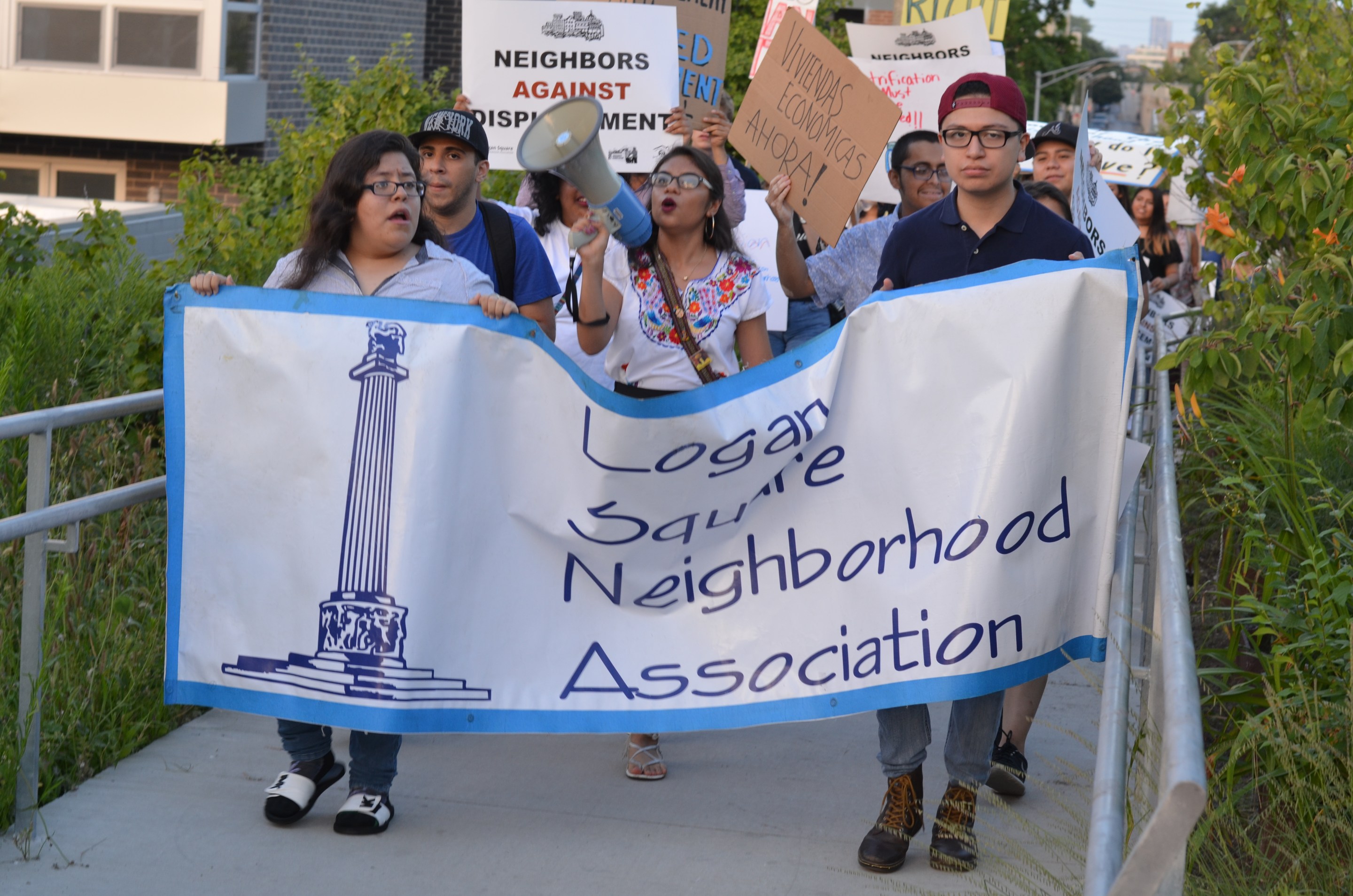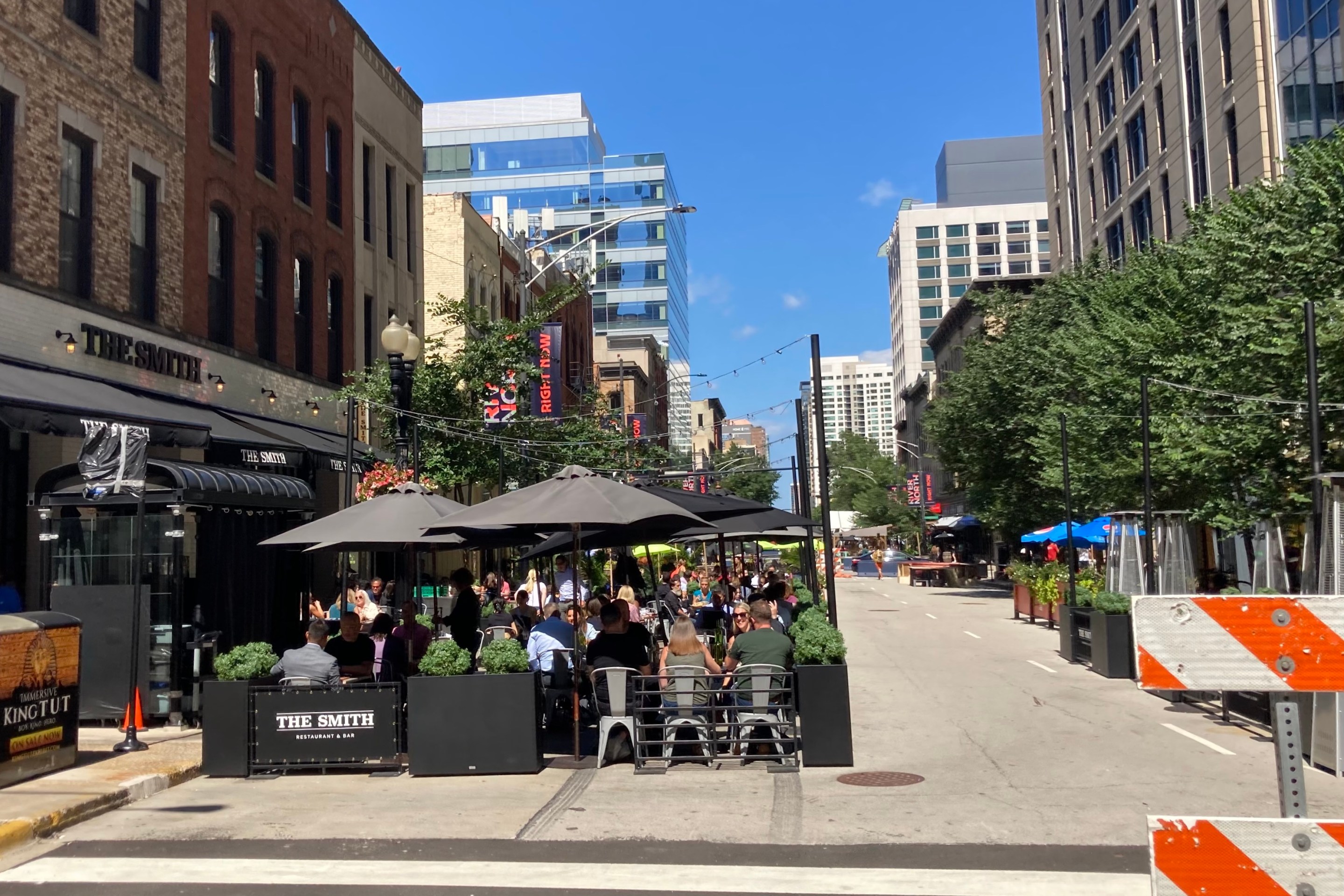Why Transportation Advocates Should Get Behind the Affordable Housing Movement
3:47 PM CDT on August 10, 2017

Youth leaders from LSNA, including Ashley Galvan Ramos, center, on the 606 during the recent demonstation. Photo: Iris Postma, LSNA
[The Chicago Reader publishes a weekly transportation column written by Streetsblog Chicago editor John Greenfield. We syndicate the column on Streetsblog after it comes out online.]
On the evening of July 19, anyone hoping to take a quiet stroll, jog, or bike ride on the west end of the 606 was out of luck. At California Avenue, young Latino activists formed a human wall across the elevated path, demonstrating against the real estate feeding frenzy that they say is displacing lower-income and working-class residents along the popular greenway.
They held aloft signs that read "Viviendas economicas ahora!" ("Affordable housing now!") and "Now that the neighborhood is nice, why do I have to move?" According to a report from DNAinfo’s Mina Bloom, most of the runners and bike riders who encountered the blockade turned around without talking to the protesters.
The activists were there to build support for the Pilot Act for the Preservation of Affordable Housing in the 606 Residential Area, legislation that these youth leaders for the Logan Square Neighborhood Association (LSNA) helped craft, which would levy stiff fees on developers who demolish existing housing along the trail to make room for new buildings. The ordinance, introduced in May by three local Latino aldermen, would charge an additional fee of between $300,000 and $650,000 for teardowns, depending on how many units would be lost, as well as a fee for enlarging existing buildings. The law would cover the area bounded by Western, Kostner, Palmer, and Hirsch, along the western half of the trail, which includes parts of Logan Square and Humboldt Park.
The revenue from the fees would go into an affordable housing fund overseen by a board composed of aldermen and reps from community groups like the LSNA and Latin United Community Housing Association (LUCHA), plus staff from the city's Buildings and Planning and Development Departments. Developers could avoid the fees by setting aside half of their new units for affordable housing.
The demonstration, organized by the LSNA and LUCHA, began with a rally in front of Humboldt Park United Methodist Church, located a few blocks north of the 606. Residents gave impassioned testimony about how rising property values, property taxes, and rents, attributed to the path, are changing the demographics of the area. While this part of town was already gentrifying well before the recreation trail opened in June 2015, a recent report from DePaul's Institute for Housing Studies indicates that the greenway has accelerated that trend. The study found that property values along the western stretch of trail have gone up by 48.2 percent since construction began on the greenway.
Along with the 606, another recent development blamed for the displacement of longtime Logan Square residents is the recent boom in the construction of transit-oriented developments—parking-lite residential towers near train stations—along the Blue Line. The city's TOD ordinance, passed in 2013 and beefed up in 2015, generally waives the usual parking requirements for new housing near el and Metra stations and allows for additional density. While this encourages car-free living, almost all of the Logan developments are upscale apartment buildings, generally with 10 percent of the units designated as affordable.
Eighteen-year-old Ashley Galvan Ramos, one of the LSNA youth leaders who spoke at the rally, told me that before the 606 opened she observed many low-income families living in the corridor, but in recent years many of their homes have been replaced by upscale condos and townhouses. "It seems like gentrification has been happening really fast," she says. While Ramos doesn't live near the trail, she's lived her entire life in Logan Square and said she's worried about being pushed out of the neighborhood by rising housing costs. "This ordinance is to protect our community and help ensure that we can stay in the place that we call home."
Interestingly, one of the groups present at the rally to show support for the activists was the Active Transportation Alliance, the region's walking, biking, and transit advocacy organization, which was one of the leading boosters for building the 606, and has been a staunch supporter of the TOD movement. Active Trans has argued that new greenways help improve public health, reduce congestion and pollution, and help boost local businesses, and that transit-friendly housing reduces dependence on cars. So it might seem like a case of strange bedfellows that staffers from the group showed up for the demonstration and marched with the youth to the trail blockade.

Active Trans trail advocacy manager Steve Simmons says that supporting measures to help mitigate the gentrifying effect of neighborhood investments is a logical evolution for his organization, which was launched in 1985 as strictly a pro-cycling organization, the Chicagoland Bicycle Federation. "We felt we couldn't overlook the context in which walking, bicycling, and public transit occur given our mission is to promote healthy, sustainable and equitable communities," he says. "We see the need for policy solutions that prevent displacement."
Simmons adds that the 606 ordinance aligns with Active Trans's goal of promoting dense, affordable development near transit, since it discourages downzoning, which decreases the supply of housing and makes it more expensive. "Unfortunately, Chicago has been stagnant and even losing population near transit, partially due to the conversion of multiunit buildings to single-family homes on the north side," he says. "We realize the ordinance is not the only solution, but it's a great way to start the conversation on an issue that to date has been largely overlooked."
In a recent post on Active Trans's blog, Simmons wrote, "We'd love to see more people using active modes of transportation to get around the city. But the growth of trail networks must be carefully planned so they do not displace longtime residents."
This is starting to emerge as a citywide issue. In March 2016, Mayor Rahm Emanuel announced plans for the Paseo, a street-level promenade that will wind several miles from Pilsen to Little Village along a disused rail corridor, with landscaping, gathering places, and public art. Reps from community groups such as the Little Village Environmental Justice Organization told me that they're in favor of more open space and recreational opportunities in the area. However, they said they may pull their support for the Paseo if the city isn't proactive about preserving affordability along the corridor so that current residents can stay in the neighborhood to enjoy it.
Likewise, in the wake of the 606 opening, a proposal to build the Englewood Line Nature Trail on a similar railroad embankment has raised questions about whether such a greenway would lead to higher housing costs in that struggling south-side community.
It's worth noting that while building beautiful bike trails like the 606 and high-end TODs can contribute to higher property values, taxes, and rents, Chicago's car-centric status quo also affects residents' ability to afford housing. Recent Harvard research found that transportation convenient to jobs is the most important factor for people escaping poverty. But car ownership is expensive, so if driving is your only practical option to get to work, it takes a major bite out of your paycheck. Moreover, the city builds and maintains roads and deals with the aftermath of traffic crashes, and taxpayers foot the massive bill for that.
Active Trans is right to support a holistic approach to planning trails and TODs that includes measures for preventing displacement. Moreover, all sustainable transportation advocates trying to get more Chicagoans walking, biking, and riding transit should get behind the affordable housing movement. After all, we're not really moving the needle if it's mostly well-to-do white folks who benefit from new city amenities.
In addition to editing Streetsblog Chicago, John writes about transportation and other topics for additional local publications. A Chicagoan since 1989, he enjoys exploring the city on foot, bike, bus, and 'L' train.
Stay in touch
Sign up for our free newsletter
More from Streetsblog Chicago
Today’s Headlines for Friday, April 19
Tasty news: Friedman Properties is trying to break the Clark outdoor dining stalemate by applying for street closure permits
Mayor Johnson's administration and Ald. Reilly haven't yet found common ground on bringing back the popular car-free zone. Will this make the difference?
Roger that! Streetsblog SF editor Roger Rudick offers constructive criticism of Chicago’s downtown bike network
"There were blocks that felt very safe and very secure," he said. "But then you're immediately – voom! – disgorged into three lanes of moving traffic with no protection."


